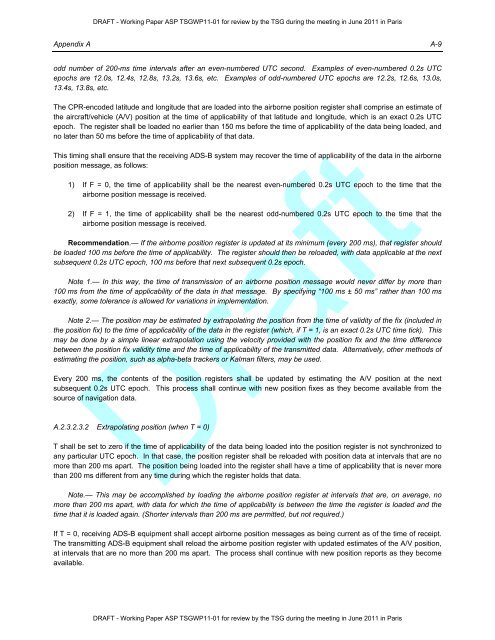Technical Provisions for Mode S Services and Extended Squitter
Technical Provisions for Mode S Services and Extended Squitter
Technical Provisions for Mode S Services and Extended Squitter
Create successful ePaper yourself
Turn your PDF publications into a flip-book with our unique Google optimized e-Paper software.
DRAFT - Working Paper ASP TSGWP11-01 <strong>for</strong> review by the TSG during the meeting in June 2011 in Paris<br />
Appendix A A-9<br />
odd number of 200-ms time intervals after an even-numbered UTC second. Examples of even-numbered 0.2s UTC<br />
epochs are 12.0s, 12.4s, 12.8s, 13.2s, 13.6s, etc. Examples of odd-numbered UTC epochs are 12.2s, 12.6s, 13.0s,<br />
13.4s, 13.8s, etc.<br />
The CPR-encoded latitude <strong>and</strong> longitude that are loaded into the airborne position register shall comprise an estimate of<br />
the aircraft/vehicle (A/V) position at the time of applicability of that latitude <strong>and</strong> longitude, which is an exact 0.2s UTC<br />
epoch. The register shall be loaded no earlier than 150 ms be<strong>for</strong>e the time of applicability of the data being loaded, <strong>and</strong><br />
no later than 50 ms be<strong>for</strong>e the time of applicability of that data.<br />
This timing shall ensure that the receiving ADS-B system may recover the time of applicability of the data in the airborne<br />
position message, as follows:<br />
1) If F = 0, the time of applicability shall be the nearest even-numbered 0.2s UTC epoch to the time that the<br />
airborne position message is received.<br />
2) If F = 1, the time of applicability shall be the nearest odd-numbered 0.2s UTC epoch to the time that the<br />
airborne position message is received.<br />
Recommendation.— If the airborne position register is updated at its minimum (every 200 ms), that register should<br />
be loaded 100 ms be<strong>for</strong>e the time of applicability. The register should then be reloaded, with data applicable at the next<br />
subsequent 0.2s UTC epoch, 100 ms be<strong>for</strong>e that next subsequent 0.2s epoch.<br />
Note 1.— In this way, the time of transmission of an airborne position message would never differ by more than<br />
100 ms from the time of applicability of the data in that message. By specifying “100 ms ± 50 ms” rather than 100 ms<br />
exactly, some tolerance is allowed <strong>for</strong> variations in implementation.<br />
Note 2.— The position may be estimated by extrapolating the position from the time of validity of the fix (included in<br />
the position fix) to the time of applicability of the data in the register (which, if T = 1, is an exact 0.2s UTC time tick). This<br />
may be done by a simple linear extrapolation using the velocity provided with the position fix <strong>and</strong> the time difference<br />
between the position fix validity time <strong>and</strong> the time of applicability of the transmitted data. Alternatively, other methods of<br />
estimating the position, such as alpha-beta trackers or Kalman filters, may be used.<br />
Every 200 ms, the contents of the position registers shall be updated by estimating the A/V position at the next<br />
subsequent 0.2s UTC epoch. This process shall continue with new position fixes as they become available from the<br />
source of navigation data.<br />
A.2.3.2.3.2 Extrapolating position (when T = 0)<br />
Draft<br />
T shall be set to zero if the time of applicability of the data being loaded into the position register is not synchronized to<br />
any particular UTC epoch. In that case, the position register shall be reloaded with position data at intervals that are no<br />
more than 200 ms apart. The position being loaded into the register shall have a time of applicability that is never more<br />
than 200 ms different from any time during which the register holds that data.<br />
Note.— This may be accomplished by loading the airborne position register at intervals that are, on average, no<br />
more than 200 ms apart, with data <strong>for</strong> which the time of applicability is between the time the register is loaded <strong>and</strong> the<br />
time that it is loaded again. (Shorter intervals than 200 ms are permitted, but not required.)<br />
If T = 0, receiving ADS-B equipment shall accept airborne position messages as being current as of the time of receipt.<br />
The transmitting ADS-B equipment shall reload the airborne position register with updated estimates of the A/V position,<br />
at intervals that are no more than 200 ms apart. The process shall continue with new position reports as they become<br />
available.<br />
DRAFT - Working Paper ASP TSGWP11-01 <strong>for</strong> review by the TSG during the meeting in June 2011 in Paris
















